Cathedral of St. Joseph (Manchester, New Hampshire)
19th-century Roman Catholic church buildings in the United StatesCathedrals in New HampshireChurches in Hillsborough County, New HampshireIrish-American culture in New HampshireNew Hampshire church stubs ... and 6 more
Religious organizations established in 1884Roman Catholic cathedrals in the United StatesRoman Catholic churches completed in 1894Roman Catholic churches in Manchester, New HampshireTourist attractions in Manchester, New HampshireUnited States Roman Catholic cathedral stubs

The Cathedral of St. Joseph is the cathedral church of the Roman Catholic Diocese of Manchester in New Hampshire, United States. It is located at 145 Lowell Street in the downtown district. Bishop Peter Libasci serves as Bishop of the Diocese of Manchester, and Father Jason Jalbert is the rector of the cathedral parish.
Excerpt from the Wikipedia article Cathedral of St. Joseph (Manchester, New Hampshire) (License: CC BY-SA 3.0, Authors, Images).Cathedral of St. Joseph (Manchester, New Hampshire)
Lowell Street, Manchester
Geographical coordinates (GPS) Address External links Nearby Places Show on map
Geographical coordinates (GPS)
| Latitude | Longitude |
|---|---|
| N 42.993333333333 ° | E -71.458888888889 ° |
Address
St. Joseph Cathedral
Lowell Street
03104 Manchester
New Hampshire, United States
Open on Google Maps






